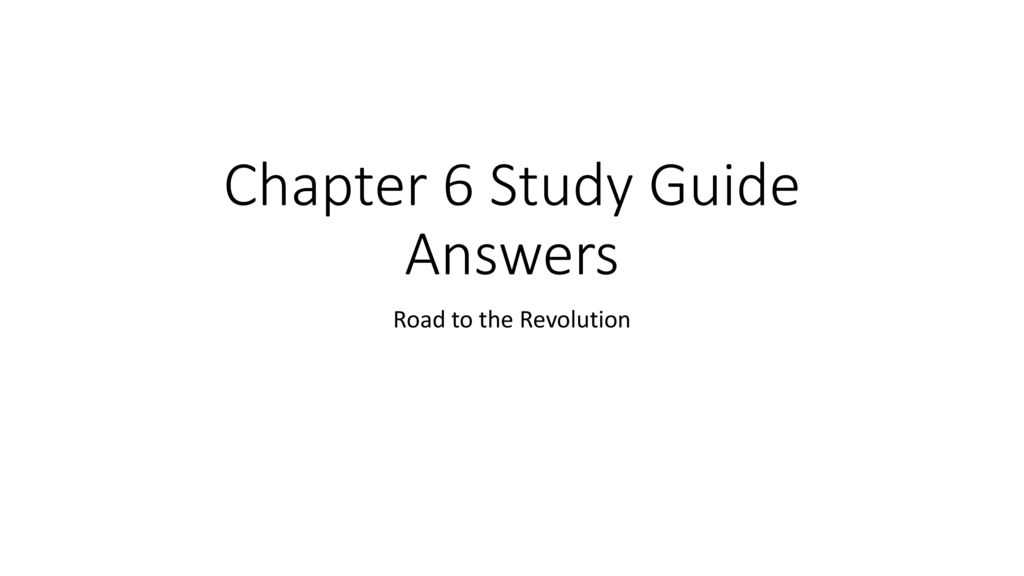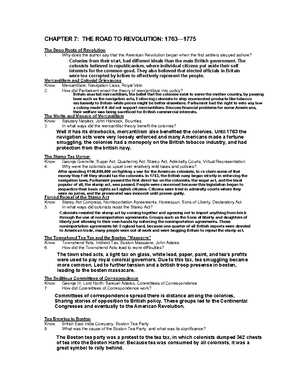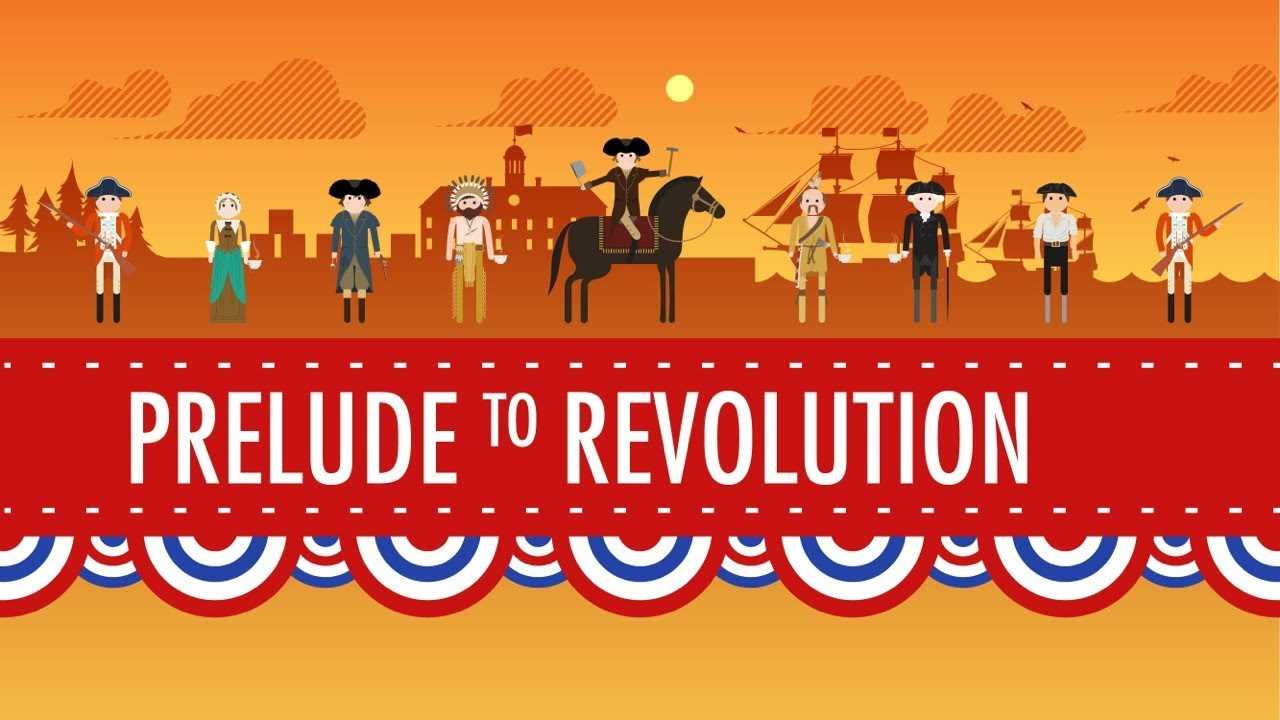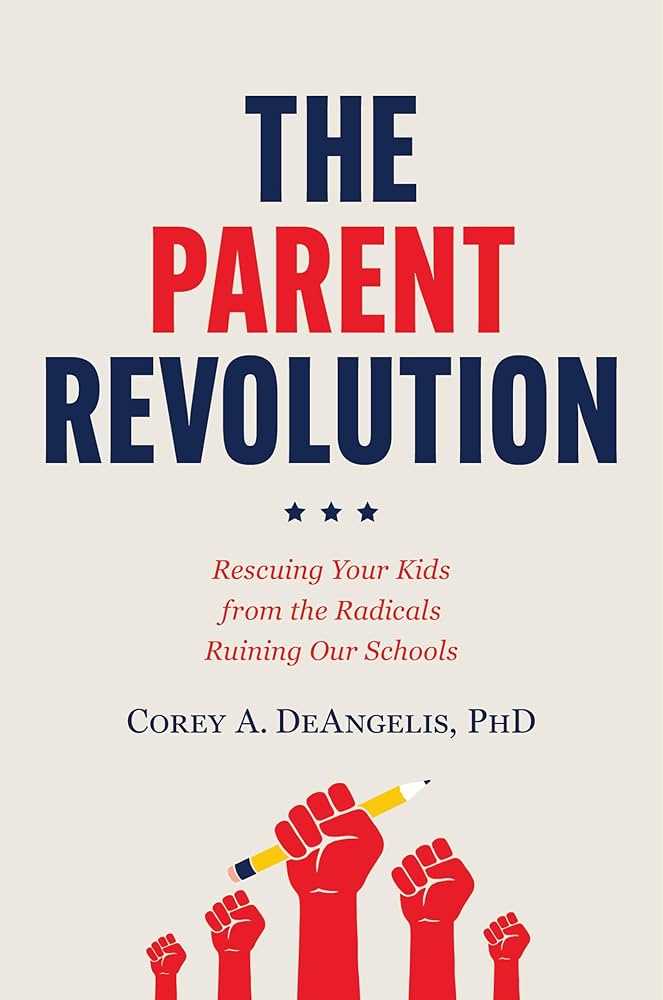
During the early years of colonial life, tensions between the American colonies and their governing powers began to rise, setting the stage for significant political and social change. Discontent among the colonists grew as they faced various challenges and restrictions imposed by distant rulers, leading to a series of pivotal events that shaped the future of the nation. These developments would eventually bring about dramatic shifts in power, setting the foundation for independence.
Numerous factors contributed to the escalating friction, including unfair taxation, limited representation, and growing dissatisfaction with the way colonial affairs were handled. As these grievances mounted, the colonists became increasingly united in their desire for a system that respected their rights and freedoms. Key moments in history not only ignited a spirit of resistance but also defined the struggle for self-determination.
Exploring these critical turning points allows us to understand how a series of seemingly small actions and decisions ultimately led to the formation of a new nation, one that would break away from its colonial roots and chart its own course in the world. This period marked the beginning of a transformative journey for the American people, one filled with both challenges and triumphs.
Key Turning Points in Early American History
The period leading up to significant changes in colonial governance was marked by escalating tensions and transformative events. Relationships between the colonies and their ruling authority grew increasingly strained as policies and regulations clashed with the interests of local communities. This era set the stage for organized efforts to challenge control and assert autonomy.
Among the pivotal moments were actions and decisions that united diverse groups in pursuit of shared goals. These efforts were fueled by widespread dissatisfaction with economic pressures, political restrictions, and perceived injustices. By examining these developments, we gain insight into the motivations and strategies that shaped a historic movement toward independence.
This section provides an overview of major milestones, influential figures, and collective actions that defined this transformative chapter in history. Understanding these key elements reveals the complexity and resilience of those who laid the groundwork for change.
Key Events Leading to Revolution
In the years preceding the fight for independence, several pivotal events sparked widespread unrest among the colonists. These moments revealed the growing divide between the colonies and their governing authority, setting in motion a chain of actions that would eventually lead to open resistance and the quest for self-governance.
The Stamp Act of 1765
One of the earliest sources of tension was the Stamp Act, which imposed a direct tax on a variety of printed materials in the colonies. Colonists saw this as an infringement on their rights, and protests soon spread across the American territories.
- The tax affected newspapers, legal documents, and other everyday materials.
- Colonists believed it violated their right to be taxed only by representatives they elected.
- In response, widespread boycotts of British goods took place.
The Boston Massacre
The Boston Massacre further fueled colonial anger and resentment. Tensions had been rising in the city, where British soldiers were stationed to maintain order. On March 5, 1770, a confrontation escalated, resulting in the deaths of five colonists at the hands of British troops.
- This event was widely publicized and used as propaganda to rally support against British rule.
- It galvanized many colonists to see British troops as an occupying force, intensifying the call for independence.
These and other critical events, such as the Boston Tea Party and the Intolerable Acts, collectively built a sense of unity and urgency among the colonies, pushing them closer to rebellion and, ultimately, the declaration of independence.
Causes of Colonial Discontent

The growing sense of dissatisfaction among the colonists was driven by several key factors that created tension between the American territories and their distant rulers. Economic hardships, political restrictions, and perceived injustices played significant roles in shaping the mood of the colonists, leading to a widespread desire for change.
Unfair Taxation and Economic Control
One of the main sources of frustration was the burden of taxes imposed on the colonies without their consent. The British government implemented a series of laws, such as the Sugar Act and Stamp Act, which taxed essential goods and services that the colonists had little control over.
- Colonists felt these taxes were unjust because they had no representation in Parliament.
- The economic strain caused by these policies led to protests and boycotts of British goods.
- The taxes also stifled local businesses and limited economic freedom.
Restricted Political Rights
Another source of discontent was the limited political power granted to the colonies. Despite their growing populations and thriving economies, the colonists had little say in their own governance.
- Colonial assemblies were often overruled by British-appointed governors.
- Colonists were denied the ability to make their own laws or control local affairs.
- This lack of self-representation fueled feelings of alienation and frustration.
These economic and political factors, combined with other grievances, ultimately led the colonists to question the legitimacy of British rule, setting the stage for resistance and, eventually, the quest for independence.
Important Figures in the Conflict for Independence
Throughout the struggle for freedom, certain individuals played pivotal roles in shaping the direction of events and inspiring others to take action. These key figures were leaders, thinkers, and activists who brought different strengths and perspectives to the fight, helping to unite the colonies in their shared pursuit of self-determination.
George Washington
As a military leader and the eventual first President, Washington’s role was crucial in organizing and leading colonial forces during the war. His leadership and determination helped maintain morale and unity among the troops, even during the most challenging moments.
- Commanded the Continental Army through difficult battles.
- Symbolized the fight for freedom and helped solidify colonial resolve.
- Played a key role in diplomatic efforts after the war.
Thomas Paine
Paine’s writings, particularly “Common Sense,” were instrumental in shaping public opinion and galvanizing support for independence. His ability to communicate complex ideas in a simple and persuasive manner made him one of the most influential voices of the time.
- Encouraged ordinary people to support independence with his compelling arguments.
- His work helped shift public sentiment toward breaking away from British rule.
- Advocated for the creation of a new government based on equality and liberty.
These individuals, along with many others, made significant contributions that helped steer the colonies toward a new and independent future. Their legacy continues to be celebrated as foundational to the principles of freedom and democracy.
The Role of the British Crown

The British monarchy played a significant role in shaping the political and economic landscape of the American colonies. As the ultimate authority, the Crown’s policies and decisions directly impacted the daily lives of colonists, often fueling tensions that led to resistance and demands for greater autonomy.
King George III, in particular, became a symbol of colonial oppression. His policies, such as enforcing taxes and controlling trade, were seen as measures that limited the freedoms and rights of American colonists. Many colonists viewed these actions as an overreach of power, sparking protests and widespread opposition.
The Crown’s refusal to grant political representation to the colonies only deepened the divide. Colonial assemblies were often ignored, and governors appointed by the British were given significant control over local affairs, causing resentment among those who believed in self-governance.
Despite these challenges, the Crown remained firm in its stance, ultimately pushing the colonies toward a breaking point. The monarchy’s actions helped unify disparate colonial groups, ultimately leading to the desire for independence and the eventual formation of a new nation free from royal control.
Colonial Reactions to British Policies
The imposition of various laws and taxes by the British government led to strong reactions from the American colonies. As colonial resentment grew, protests and collective actions emerged, as colonists began to challenge the authority of their distant rulers. These responses ranged from peaceful resistance to more direct acts of defiance.
Protests and Boycotts
In response to taxes and restrictions, such as the Stamp Act and Townshend Acts, colonists organized widespread protests. One of the most effective forms of resistance was the boycott of British goods, which impacted British merchants and traders.
- Colonists refused to purchase British goods, hurting British businesses.
- Women played a key role in organizing household production of goods to replace British imports.
- Protests also included public demonstrations and petitions to repeal the laws.
Direct Acts of Defiance
As tensions escalated, some actions became more confrontational. Colonists began openly defying British laws, often in symbolic and highly visible ways. These acts of rebellion contributed to a growing sense of unity and resistance across the colonies.
- The Boston Tea Party, where colonists dumped tea into the harbor, was a major act of defiance against the Tea Act.
- Other protests included the destruction of British goods and violent confrontations with British soldiers.
- These actions were designed to challenge British authority and assert the colonies’ right to self-determination.
These responses to British policies not only demonstrated the colonists’ growing dissatisfaction but also laid the groundwork for a united effort to push for independence. The more the British government tried to enforce control, the stronger the pushback became, ultimately leading to the outbreak of open conflict.
The Impact of the Stamp Act
The Stamp Act of 1765 had far-reaching consequences for the American colonies, igniting widespread anger and resistance. The law, which required colonists to purchase special stamped paper for legal documents, newspapers, and other printed materials, was seen as an unfair tax imposed without local representation. This act was one of the first significant instances of British interference in colonial affairs, and its impact was felt deeply across the colonies.
In response to the Stamp Act, the colonies united in opposition, organizing protests, boycotts, and petitions to demand its repeal. The act became a symbol of British tyranny and fueled a growing sense of unity among the colonies. It also led to the formation of the Stamp Act Congress, where representatives from various colonies gathered to coordinate their resistance efforts.
| Consequences | Impact |
|---|---|
| Widespread Protests | Colonists organized demonstrations and refused to purchase stamped paper, hurting British merchants. |
| Formation of the Stamp Act Congress | Colonial leaders met to discuss collective action and to draft petitions for repeal. |
| Increased Tensions | The act escalated tensions between Britain and the colonies, creating a foundation for future conflicts. |
| Repeal of the Act | The intense colonial resistance led to the eventual repeal of the Stamp Act in 1766. |
The Stamp Act ultimately marked a turning point in colonial relations with Britain, as it demonstrated the power of united resistance. Although the law was eventually repealed, it set the stage for further confrontations and laid the groundwork for the eventual push for independence.
The Boston Massacre and Its Aftermath

The violent clash between British soldiers and colonial residents in Boston marked a pivotal moment in the growing conflict between the colonies and Britain. Tensions had been escalating for months, fueled by the presence of British troops stationed in the city to enforce unpopular laws. On the night of March 5, 1770, the situation boiled over, leading to the deaths of five colonists and sparking outrage across the colonies.
In the immediate aftermath, the event was quickly branded as a massacre, with colonists using the incident to rally against British rule. The image of innocent citizens being killed by British soldiers was used to inflame public opinion and encourage resistance to British policies. Propaganda played a significant role in shaping the narrative, with influential figures like Paul Revere producing engravings that exaggerated the violence of the event to stir up anger.
Although the soldiers involved were tried and acquitted, the event left a lasting impact on colonial sentiment. It heightened the distrust of British authority and added fuel to the growing desire for independence. The massacre became a powerful symbol of British oppression, further deepening the divide between the colonies and their rulers.
The aftermath of the Boston Massacre saw a sharp increase in anti-British sentiment, leading to more widespread protests and calls for unity among the colonies. The event also laid the groundwork for future demonstrations, such as the Boston Tea Party, which would take place just a few years later, as colonists sought to challenge British authority more forcefully.
The Significance of the Boston Tea Party
The Boston Tea Party of 1773 was a defining moment in the escalation of tensions between the American colonies and Great Britain. This act of defiance, in which colonists disguised as Native Americans boarded British ships and dumped an entire shipment of tea into Boston Harbor, was a direct protest against the Tea Act imposed by the British government. It symbolized the growing resentment toward British control and the desire for self-determination among the colonists.
A Bold Act of Rebellion
The Boston Tea Party was not only a protest against a specific tax but also a bold statement against British imperialism. Colonists were outraged by what they saw as the unjust monopolization of the tea trade by the British East India Company, which threatened local merchants and infringed upon their economic freedoms. By destroying the tea, the colonists sent a powerful message that they would no longer tolerate such measures.
Escalation of Hostilities
The British response to the Boston Tea Party was swift and harsh. In retaliation, Parliament passed a series of punitive measures known as the Coercive Acts (or Intolerable Acts), which further limited colonial self-governance and freedoms. These actions only fueled anger and resistance among the colonies, uniting them in opposition to British authority and setting the stage for open rebellion.
The Boston Tea Party’s significance extends beyond its immediate impact. It galvanized colonial unity and resistance, sparking a wave of protests across the colonies. It also demonstrated the willingness of the colonists to take extreme measures to challenge British rule, marking a critical turning point in the path to independence.
The Intolerable Acts Explained
The Intolerable Acts, also known as the Coercive Acts, were a series of punitive measures enacted by the British government in response to the Boston Tea Party of 1773. Aimed at reasserting British control over the colonies, these laws were seen by colonists as severe and unjust, leading to widespread outrage and resistance. The acts were designed to punish Massachusetts for its role in the tea protest and to serve as a warning to the other colonies against defying British authority.
Key Provisions of the Intolerable Acts
Among the most significant provisions of the Intolerable Acts were:
- Boston Port Act: This closed Boston’s harbor until the destroyed tea was paid for, crippling the city’s economy and isolating it from the rest of the colonies.
- Massachusetts Government Act: This law drastically reduced the powers of self-government in Massachusetts, placing more control in the hands of royal officials.
- Administration of Justice Act: This allowed British officials accused of crimes in the colonies to be tried in Britain or other colonies, making it difficult for colonists to seek justice.
- Quartering Act: This required colonial assemblies to provide housing for British troops stationed in the colonies, further aggravating tensions.
Colonial Response

The Intolerable Acts had a profound effect on the colonies, uniting them in opposition to what they perceived as British tyranny. Colonial leaders quickly recognized the need for coordinated action, leading to the formation of the First Continental Congress in 1774. The congress called for a boycott of British goods and drafted a petition to King George III, demanding the repeal of the Intolerable Acts and greater colonial autonomy.
Instead of restoring order, the Intolerable Acts pushed the colonies closer to open rebellion, setting the stage for the armed conflicts that would soon follow.
Colonial Unity and Early Resistance
In the face of growing British oppression, the American colonies began to recognize the importance of unity in their struggle for greater autonomy. As tensions rose due to various acts and policies imposed by Britain, colonists began to set aside regional differences and form a more cohesive resistance movement. This period marked the beginning of organized efforts to push back against British authority, as various forms of protest and cooperation emerged throughout the colonies.
First Signs of Coordination
One of the early expressions of colonial unity was the formation of the Stamp Act Congress in 1765, which brought together representatives from several colonies to protest the Stamp Act. The congress issued a unified declaration of rights and grievances, calling for the repeal of the act. Although the Stamp Act was eventually repealed, this marked a critical step in the colonies’ growing cooperation and willingness to resist British policies together.
Resistance Movements and Boycotts

As more unpopular laws were passed, such as the Townshend Acts and the Tea Act, resistance efforts gained momentum. The colonies began to coordinate economic boycotts, refusing to purchase British goods in an effort to hurt Britain’s economy. In addition, groups like the Sons of Liberty were formed to organize protests, intimidate loyalists, and take action against British officials. These efforts helped spread the message of resistance and paved the way for more direct actions, including the Boston Tea Party.
The growing unity among the colonies during this period was a key factor in strengthening their resolve and readiness for the conflicts that would follow. By the time the first shots were fired at Lexington and Concord, colonial unity had become an essential force in the fight for independence.
The First Continental Congress

The First Continental Congress marked a pivotal moment in colonial history, as delegates from twelve colonies came together in 1774 to discuss a unified response to the harsh British measures that had recently been imposed. Faced with increasing repression and the threat of further restrictions, colonial leaders recognized the need to act in solidarity. This gathering was not only a response to the intolerable laws but also the beginning of formal collective action to protect colonial rights and liberties.
Objectives and Actions
The congress aimed to address the growing tensions between the colonies and Britain, with a focus on organizing a coordinated response to British policies. Some of its key actions included:
- Boycotts: A call for a widespread boycott of British goods in order to economically pressure Britain and demonstrate the colonies’ collective resistance.
- Petition: A petition was sent to King George III, expressing colonial grievances and seeking a redress of their concerns, hoping for a peaceful resolution.
- Committees of Correspondence: The congress endorsed the formation of local committees of correspondence to facilitate communication and keep colonial citizens informed about British actions.
Key Figures and Decisions
The congress was attended by influential leaders such as John Adams, Samuel Adams, Patrick Henry, and George Washington, who would play key roles in the unfolding conflict. The delegates agreed on the importance of maintaining unity and decided to reconvene if their grievances were not addressed. Although the congress did not yet seek outright independence, it represented a significant step toward greater unity and collaboration among the colonies.
The First Continental Congress helped establish the groundwork for further political actions and set the stage for the next steps toward rebellion. The decisions made during this congress were crucial in strengthening colonial resolve and ultimately leading to the outbreak of armed conflict with Britain.
The Outbreak of the Revolutionary War
The conflict between the colonies and Britain finally reached its boiling point in 1775, when escalating tensions and confrontations led to open warfare. What had begun as a struggle for colonial rights and opposition to oppressive policies soon evolved into a full-scale military conflict. Several key events played a critical role in sparking the fighting, leading to the start of a war that would change the course of history.
Key Events Leading to Armed Conflict
The first battles were fought when British troops attempted to seize colonial arms and arrest revolutionary leaders. Key incidents included:
- Lexington and Concord: On April 19, 1775, British forces marched to seize weapons stored in Concord. Colonists in Lexington confronted them, and the fighting quickly spread, marking the beginning of open hostilities.
- Bunker Hill: In June 1775, colonial militias faced British troops at Bunker Hill. While technically a British victory, the heavy losses they sustained demonstrated the determination and resilience of the colonial forces.
Colonial Response and Escalation
In response to these battles, colonial militias began to organize more effectively. While some leaders still hoped for reconciliation, many understood that armed resistance was the only way to secure their rights. As British forces continued to push into colonial territory, more colonists joined the cause, creating an increasingly powerful and unified opposition.
The outbreak of war marked the shift from political resistance to armed conflict, signaling the start of a long and bloody struggle for independence. The battles at Lexington and Concord were not just military engagements but also symbolic acts that confirmed the colonies’ commitment to fighting for their freedoms, no matter the cost.
The Battle of Lexington and Concord
In April 1775, escalating tensions between the colonies and Britain led to the first significant military engagements of the conflict. British troops, tasked with seizing colonial arms and arresting key figures, encountered unexpected resistance from colonial militias, marking the start of the open conflict that would eventually lead to independence. The confrontations at Lexington and Concord became the spark that ignited a full-scale war.
Prelude to Conflict
The British military had been aware of growing unrest and the formation of local militias in the colonies. Intelligence reports indicated that the colonial rebels were stockpiling weapons and ammunition in Concord. To prevent further escalation, British troops were dispatched to seize the arms and capture rebel leaders. However, colonial intelligence networks were already in motion, and the militias were prepared for action.
The Battle
The first confrontation took place at Lexington, where about 70 colonial militia members faced off against nearly 700 British soldiers. The “shot heard ’round the world” marked the beginning of the battle as British troops attempted to march on to Concord. At Concord, the British encountered even stronger resistance. Colonial militias had gathered in greater numbers, and the British were forced to retreat back to Boston under heavy fire. The day marked a significant victory for the colonists, as it demonstrated their willingness to fight for their rights.
| Location | Event | Outcome |
|---|---|---|
| Lexington | Initial confrontation between British soldiers and colonial militia | British victory but with significant colonial casualties |
| Concord | Colonial militias confront British troops, forcing them to retreat | Colonial victory, British forced to retreat to Boston |
The events of April 19, 1775, solidified the resolve of the colonial militias and marked the beginning of open conflict. The British failed to accomplish their objectives and faced fierce opposition from an increasingly unified colonial resistance. These early battles demonstrated the growing determination of the colonies to stand against British control, setting the stage for the larger war that followed.
Declaration of Independence Overview
The formal document, approved on July 4, 1776, marked a pivotal moment in history. It was a bold proclamation that sought to sever political ties with the British monarchy, justifying the decision through a list of grievances. This document not only declared the intention for independence but also set forth the principles of liberty and self-governance that would serve as the foundation for the new nation. It reflected the philosophical ideals that had been developing throughout the colonies, and it would have a lasting impact on the course of history.
Key Principles and Philosophical Foundations
At the heart of the document lies a clear assertion of universal rights, including life, liberty, and the pursuit of happiness. The authors drew upon Enlightenment ideas, particularly the works of philosophers like John Locke, to argue that governments exist to protect the rights of their people. When a government becomes destructive to those rights, the people have not only the right but the duty to alter or abolish it. This framework laid the groundwork for the idea of democratic governance and individual freedoms.
Content and Structure
Written primarily by Thomas Jefferson, the document consists of several distinct parts. It opens with a preamble explaining the necessity of explaining the reasons for separation. This is followed by a detailed list of grievances against King George III, outlining how his actions violated the natural rights of the colonists. The final section declares that the colonies are absolved from all allegiance to the British Crown, asserting their right to form their own independent government.
| Section | Purpose |
|---|---|
| Preamble | Introduces the necessity for separation and outlines the justification for declaring independence |
| List of Grievances | Details the abuses and violations by King George III against the colonies, highlighting the reasons for rebellion |
| Declaration of Independence | Officially proclaims the colonies’ independence and right to self-governance |
By issuing this declaration, the Continental Congress sought to unite the colonies in their cause for independence. The document would inspire future generations, both in the United States and globally, to seek freedom from oppressive rule. It remains a symbol of democracy and the enduring quest for human rights.
The Role of Propaganda in Revolution
Throughout history, the use of persuasive communication has played a crucial role in shaping public opinion and mobilizing people for collective action. In times of political upheaval, information, whether truthful or exaggerated, can influence emotions, spread ideologies, and rally support for a cause. This type of messaging often shapes the narrative of events, providing a tool to unite or divide societies. By framing certain actions as either heroic or villainous, propaganda can significantly alter the course of history.
Methods of Dissemination
During periods of societal tension, various media platforms, ranging from pamphlets and newspapers to visual art and speeches, serve as powerful tools for spreading information. Revolutionary leaders and sympathizers often used these methods to convey their messages and gain traction for their cause. Some common forms included:
- Printed materials: Pamphlets, newspapers, and books were printed in large quantities and distributed widely to inform the public or to incite action.
- Visual propaganda: Posters, illustrations, and caricatures were created to evoke strong emotional reactions and to portray opponents negatively.
- Public speeches: Leaders and orators used rallies and speeches to energize crowds and spread their message directly to the people.
Impact on Public Sentiment
Propaganda often works by appealing to people’s emotions, creating a sense of urgency or injustice. By highlighting perceived wrongdoings and framing them in a way that resonates with the masses, these communications can shift public sentiment. Propaganda’s effectiveness lies in its ability to simplify complex issues, turning them into binary choices, where one side is framed as entirely right, and the other as entirely wrong. This often reduces the complexity of political struggles to stark moral dichotomies, encouraging action and commitment.
| Type of Propaganda | Purpose |
|---|---|
| Pamphlets and Newspapers | To educate and persuade the public by disseminating information about key issues and events |
| Art and Illustrations | To evoke emotional responses and visually communicate key messages, often in a simplified form |
| Speeches and Rallies | To directly engage the public and inspire collective action through rhetoric and emotional appeal |
By influencing how events are perceived, propaganda can shift the balance of power in a society. Whether for or against a particular cause, its use often leads to heightened emotions and public fervor, which are essential for movements that seek to challenge the established order. As history shows, those in control of the narrative often hold a significant advantage in shaping the outcome of major societal changes.
The Global Impact of the Revolution
Movements for change often transcend national borders, inspiring similar struggles and influencing global political landscapes. The events in one country can have profound effects on others, sparking new ideas about governance, freedom, and individual rights. The outcome of such conflicts can alter the balance of power worldwide, prompting shifts in alliances, economies, and ideologies. This particular struggle not only changed the course of history within its own borders but also set the stage for a wave of reforms and uprisings across the globe.
Inspiration for Other Movements
In the years following the conflict, numerous nations looked to this transformative event as a model for their own quests for independence and self-determination. The ideas of liberty, equality, and fraternity became rallying cries for groups seeking to break free from colonial rule or oppressive monarchies. Some of the key areas influenced by these ideals include:
- France: The principles of liberty and equality sparked the French Revolution, leading to the overthrow of the monarchy and the establishment of a republic.
- Latin America: Leaders like Simón Bolívar were inspired by these ideas and led revolutions across South America against Spanish colonial rule.
- Europe: Enlightenment thinkers in Europe were deeply impacted by these events, contributing to growing support for democratic reforms across the continent.
Shifts in Global Power Structures
The success of the movement also reshaped global geopolitics, particularly in terms of colonial empires. The change in power dynamics contributed to the eventual decline of European imperial dominance, as colonial powers began to lose control over their territories. This also prompted shifts in trade routes, alliances, and the balance of military and economic power.
Additionally, the formation of new states based on democratic ideals served as a counterpoint to longstanding monarchies and empires. The recognition of new nations, as well as the establishment of republics and constitutional governments, sent a message that reshaped the global perspective on governance, individual rights, and self-determination.
In conclusion, the transformative events of this period not only altered the course of a single nation’s history but also served as a catalyst for political and social change worldwide. The ripple effects are still felt today in the ongoing pursuit of democracy, human rights, and the fight against oppression.